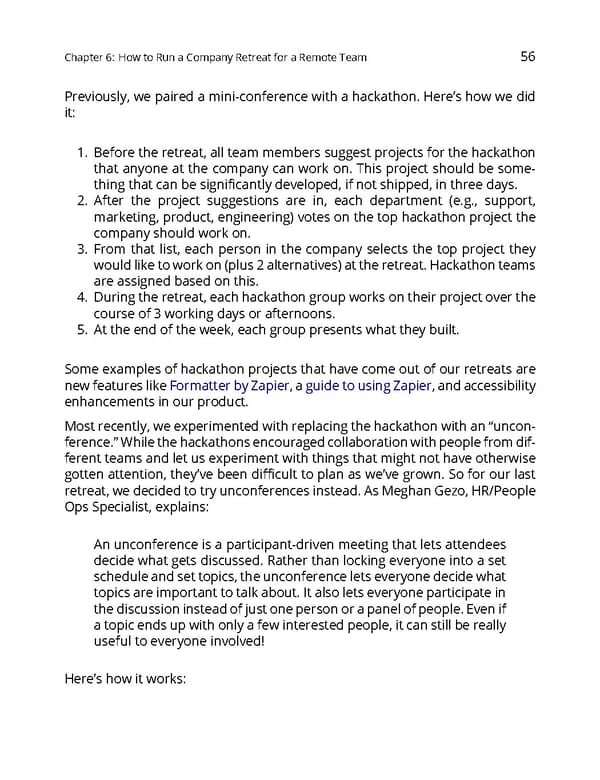Chapter6: HowtoRunaCompanyRetreatforaRemoteTeam 56 Previously, we paired a mini-conference with a hackathon. Here’s how we did it: 1. Before the retreat, all team members suggest projects for the hackathon that anyone at the company can work on. This project should be some- thing that can be significantly developed, if not shipped, in three days. 2. After the project suggestions are in, each department (e.g., support, marketing, product, engineering) votes on the top hackathon project the companyshouldworkon. 3. From that list, each person in the company selects the top project they wouldliketoworkon(plus2alternatives)attheretreat.Hackathonteams are assigned based on this. 4. During the retreat, each hackathon group works on their project over the courseof3workingdaysorafternoons. 5. At the end of the week, each group presents what they built. Someexamplesofhackathonprojectsthathavecomeoutofourretreatsare newfeatureslikeFormatterbyZapier,aguidetousingZapier,andaccessibility enhancementsinourproduct. Mostrecently,weexperimentedwithreplacingthehackathonwithan“uncon- ference.”Whilethehackathonsencouragedcollaborationwithpeoplefromdif- ferent teams and let us experiment with things that might not have otherwise gotten attention, they’ve been difficult to plan as we’ve grown. So for our last retreat, we decided to try unconferences instead. As Meghan Gezo, HR/People OpsSpecialist, explains: Anunconference is a participant-driven meeting that lets attendees decide what gets discussed. Rather than locking everyone into a set scheduleandsettopics,theunconferenceletseveryonedecidewhat topics are important to talk about. It also lets everyone participate in thediscussioninsteadofjustonepersonorapanelofpeople.Evenif atopicendsupwithonlyafewinterestedpeople,itcanstillbereally useful to everyone involved! Here’s how it works:
 The Ultimate Guide to Remote Work Page 59 Page 61
The Ultimate Guide to Remote Work Page 59 Page 61